|
There is nothing magic about free-energy and by “free-energy” I mean something which produces output energy without the need for using a fuel which you have to buy. Free energy devices have been around for a very long time now. I have stood beside a water mill and it’s power is scary as it could crush you in moments and never even notice. That mill is on a quietly flowing small river and it can operate at any time day or night without having to pay anything for the power which it uses. It will have cost quite a bit to build the mill in the first place, but after that, it produces major power year after year. Most free-energy devices are just like that as it costs to build them in the first place, but after that they run for free. This presentation is mainly for people who have never come across free-energy and know nothing about it. So, each chapter deals with just one device and tries to explain it clearly. The objective is to build a simple battery-operated light which is charged by the sun and is available for use every night. Solar panels can be very useful items in spite of their very low efficiency and high cost. When thinking about solar panels people generally imagine a set of many large solar panels mounted on the roof of a house. The cost of doing that is far too great for most people to consider it. However, at this time, there are a very large number of people in the world who do not have any electricity at all. It appears that a useful electricity feature for them would be electric lighting at night. With the components which have become available recently, providing good lighting at realistic cost is now possible. Small solar panels offered for sale as “10 watt, 12 volt” capacity can now be bought reasonably cheaply. Made in China, these panels can provide a current of just over half an amp These panels which have an aluminium frame are typically 337 x 205 x 18 mm in size and look like this:  Tests which I have run show that a 1000 lux very realistic level of lighting can be provided with a total of just 1.5 watts of electrical power. The best lighting source that I have found is the “G4” style, LED arrays made in China using the recent “5050” chip technology. These are cheap and have a very heavily non-linear light output for current draw, which is a fact which we can use to our advantage. These LED arrays come in “white” or “warm white” versions (my preference is the warm white variety) and they look like this: 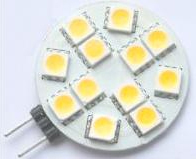 With a diameter of 30 mm and pins which are easy to connect to, these are very convenient devices which have an excellent lighting angle of 160 degrees and a light output of 165 lumens for a 1.2 watt electrical input. One of the problems with such a unit is the selection of a suitable battery. Lithium batteries are excellent but the cost of a suitable lithium battery is ten times greater than the cost envisaged for the whole unit, effectively excluding lithium batteries. Lead-acid batteries are far too large, too heavy and too expensive for this application. Surprisingly, what appears to be the best choice is the very popular AA size Nickel-Manganese rechargeable battery which is 50 mm long and 14 mm in diameter:  Rated at up to 3 Amp-Hour capacity, they are very low cost, are lightweight and can be placed in a battery box like this: 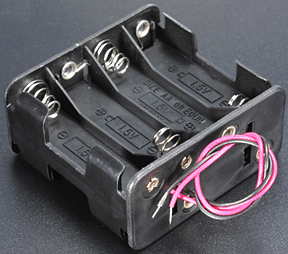 The battery box can be adapted to hold seven batteries rather than the intended eight batteries, producing a nine volt battery pack with 1.2V batteries. If three of these battery packs are used with the solar panel, then there is no need for over-charging protection as NiMh batteries can deal with overcharging current if it does not exceed 10% of the battery’s milliamp-hour rating, and that simplifies the design very considerably. However, some of these small NiMh batteries do not live up to the maker’s claims and so you need to run a load test on any particular make of battery which you may consider using. For example, here are six different types of these batteries tested in groups of four, with a load of about 50 milliamps at five volts. The same load was used to test each of these batteries: 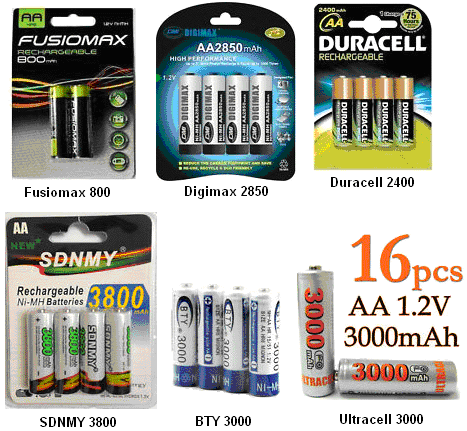 The results were most revealing: 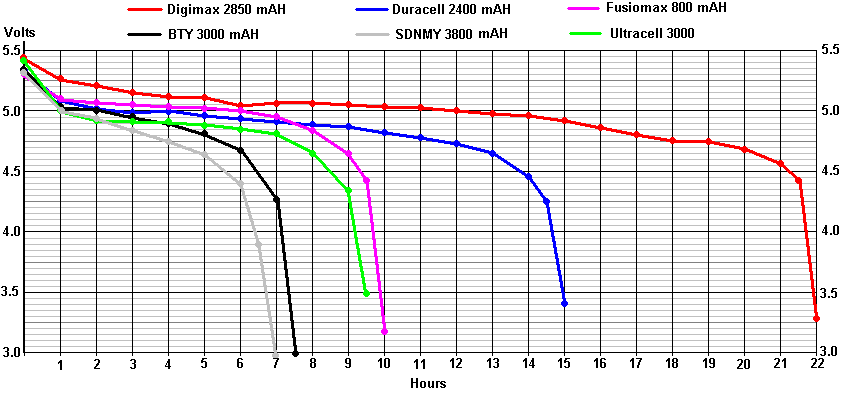 The BTY 3000 batteries do not actually claim on the battery to be 3000 mAHr (although the sellers do) and so, the “3000” could just be a trading name. The tests results for the BTY 3000 were so staggeringly poor that the test was repeated three times with longer recharging time for each test, and the one shown above is the ‘best’ result. You will notice how far short it falls when compared to the Fusiomax 800 mAHr batteries costing only fifty pence each from the local Poundland shop. The terrible performance of the BTY 3000 batteries is only exceeded by the incredible SDNMY 3800 mAHr batteries which show almost negligible capacity in spite of their amazing claims of 3800 mAHr. I leave you to judge for yourself if the claims of some of these manufacturers are actually fraudulent. NiMh batteries are 66% efficient. That means that if you feed a 1-amp current into them for three hours, they should be able to provide a 1-amp current for two hours. A current of 1-amp is, of course, too high if the battery is to have a long working life of some years, so we would only ever charge a 3000 milliamp-hour NiMh battery at 300 milliamps or less. It is actually very difficult to determine when one of these batteries is fully charged as the battery voltage is not a reliable indication of the charge level. The battery starts to get warm when fully charged. A set of ten batteries which are nominally 12-volts, will have an actual voltage between 13-volts and 14-volts typically. Overcharging is not a problem with our small solar panel. However, light meter tests provide some very interesting results for the LED arrays. When using two LED arrays side by side in a light box, the figures for voltage / current draw / light produced using 1.2-volt NiMh batteries were: 9 batteries 11.7V 206 mA 1133 lux: 2.41 watts 470 lux per watt (the manufacturer’s intended performance) 8 batteries 10.4V 124 mA 725 lux 1.29 watts 562 lux per watt 7 batteries 9.1V 66 mA 419 lux 0.60 watts 697 lux per watt (a very realistic performance level) 6 batteries 7.8V 6 mA 43 lux 0.0468 watts 918 lux per watt This is very revealing information, showing that one of these LED arrays fed with just 33 milliamps can produce very impressive 210 lux lighting at a wide angle of illumination. To put that another way, feeding five LED arrays with 9 volts, generates a very acceptable 1000-lux lighting level for just 165 milliamps which is only 1.5 watts. That is spectacular performance. Equally impressive is what happens when the battery voltage drops when the battery is nearly fully discharged. The LED performance rises to combat the loss of voltage and even at a ridiculously small 3 milliamps fed into each LED, there is a 21 lux light output from each LED array. The effect is that while the lighting does dim slightly, it does so very gradually in a barely noticeable way. With three sets of genuine high-capacity AA NiMh batteries, we can expect a minimum of eight hours of continuous 1000-lux lighting from our desk lamp. That is a total of twelve watt-hours, and the solar panel feeding 66% efficient batteries at nine volts, is capable of replacing one of those usable watt-hours in twenty minutes. In other words, just two hours forty minutes of good daytime lighting can provide eight hours of 1000-lux lighting every night. The only moving component in this system is the On/Off switch and the circuit could not be any more simple than this: 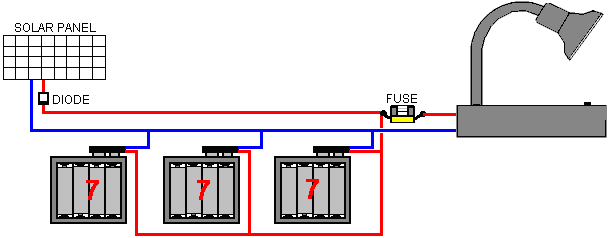 All solar panels have a diode to prevent the panel drawing current from the batteries during the hours of darkness and it is not unusual for the panel to be supplied with a diode already connected in place. Personally, I would consider a fuse to be unnecessary but it is standard practice to fit one. The batteries are installed in a base box which supports the solar panel and gives sufficient weight to produce a very stable lamp. The five LED arrays are connected in parallel and fitted into a suitable lamp housing such as this one: 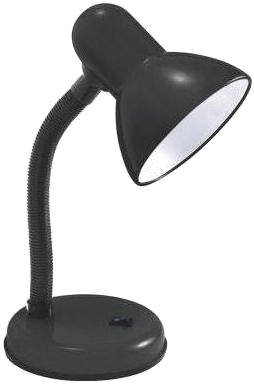 Only the flexible stem, 120 mm diameter lampshade and On/Off switch are used. While this is an exceptionally simple and robust design, it is actually an affordable and very desirable unit which can provide years of cost-free lighting at a very satisfactory level. The prototype looks like this: 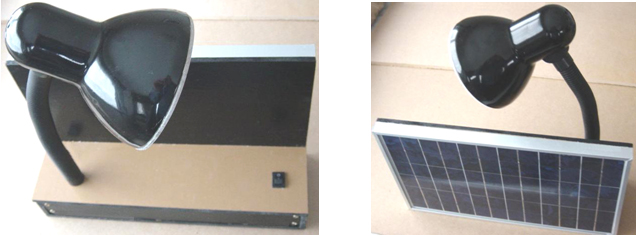 This is, of course, a perfectly ordinary and quite standard type of a solar-powered light. The difference here is that it is a very effective light suited to lighting a desk to a high level all night long. It is mobile and has a wide angle of lighting. It is also possible to extend the design very slightly, to provide an even longer period of lighting or if preferred, a period of even brighter lighting. This can be done by using eight batteries in each battery holder – which has the advantage that standard battery holders can be used without any need to adapt them to hold just seven batteries. This has the slight disadvantage that we do not want to supply the extra voltage to the LED arrays because doing that would cause a greater current draw than we want. We can overcome this by using an extra change-over switch and having two connections to each battery holder. The circuit could then become 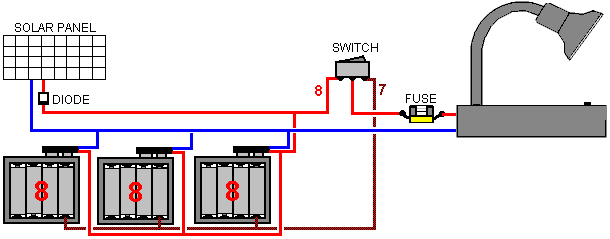 With this arrangement, the lighting unit is fed by either eight batteries or by seven batteries, depending on the position of the change-over switch. When the solar panel is charging the batteries, all eight batteries per holder get charged no matter what position the extra switch is in. This has the advantage that when the battery voltage starts to drop after a few hours of powering the light, then the switch can be operated, raising the voltage reaching the lamp by the voltage of the extra battery, possibly producing a brightness exceeding the maximum when using just seven batteries in each battery holder. This arrangement has the slight disadvantage that the user could switch in all eight batteries from the beginning, producing a much higher current drain and while that would give a higher lighting level, the overall time is likely to be reduced. Mind you, it is possible that this might suit the user If this style of operation is chosen, then I suggest that the extra switch is located well away from the On/Off switch so that the user does not get confused as to which switch does which job. Perhaps the second switch might be located near the stem of the lamp support, like this: 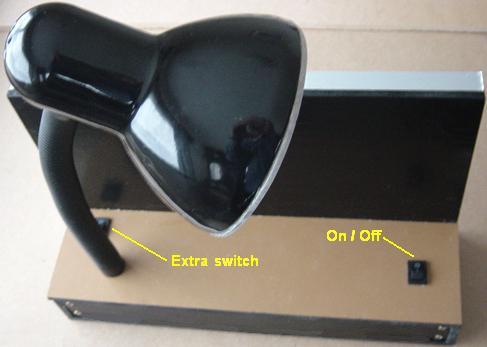 The physical layout of the components could be like this: 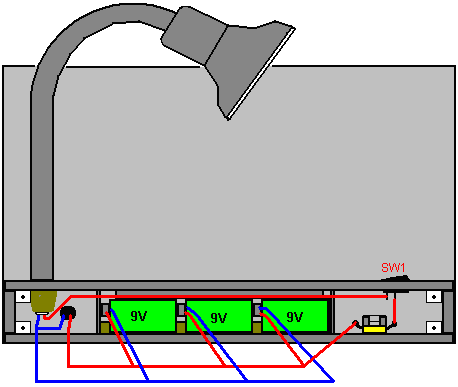 Here, the weight of the solar panel and the three battery packs give the unit stability if the lamp is bent in any direction. With four LED arrays, an excellent level of lighting results, however, I would suggest using five LED arrays as that gives an even wider range of lighting. If a commercial lamp is being used, then it needs to be taken apart now and prepared for this project. The base is removed, the bulb holder is removed and two wires are fed through the remaining shaft so that the LED arrays can be fitted. A circular disc of any kind of rigid material is cut, the diameter being slightly less than the diameter of the mouth of the lamp. Four or five LED arrays (depending on your choice of numbers) are glued to the disc and wired up in parallel with all of the plus wires connected together and to one of the wires feeding through the shaft of the lamp, and all of the minus wires connected together and attached to the other wire passing through the column of the lamp: 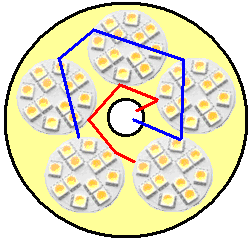 This disc is then eased through the mouth of the lamp shade where it sits about 10 mm below the rim of the shade due to the taper of the shade. Position the disc so that it is square on to the rim of the shade and glue it in position. If frosted plastic is to be used, then mark the sheet around the rim of the shade and cut out the resulting circle, drill some ventilation holes in it although the LED arrays always run cold, and glue the frosted plastic disc to the rim of the shade. Some people might prefer to have general room lighting rather than a desk lamp. That is perfectly possible and three separate lighting units can be used instead: 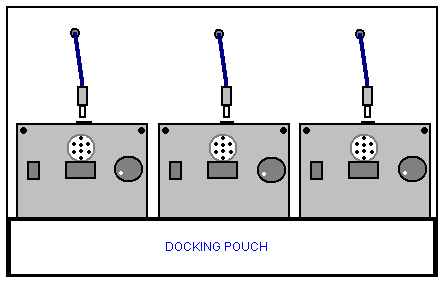 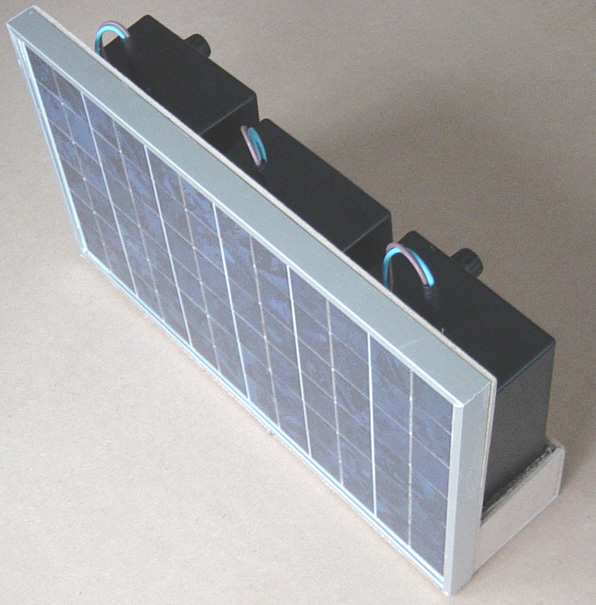 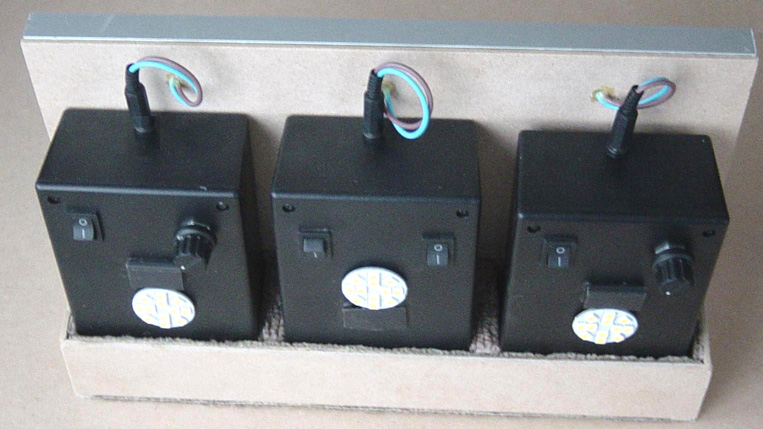 These units are particularly useful as they can be used at different points in a room to give really good lighting, or they can be used in different rooms, or they can be switched on at different times during the night. An alternative is to use many LED arrays in one unit: If a very powerful single source of lighting is needed, it is possible to use a larger solar panel, or for a more compact unit, two of the 12-volt 10-watt panels shown above. The arrangement can use the same simple manual control of lighting level and the same booster switch for even greater lighting for a few minutes. The arrangement can be like this: 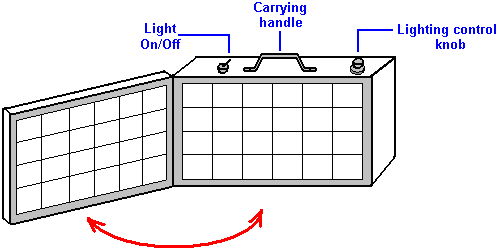 When closed over, the face of solar panel P1 faces that of solar panel P2, protecting both when the unit is being carried. An early prototype of this style of construction with the panels open, looks like this: 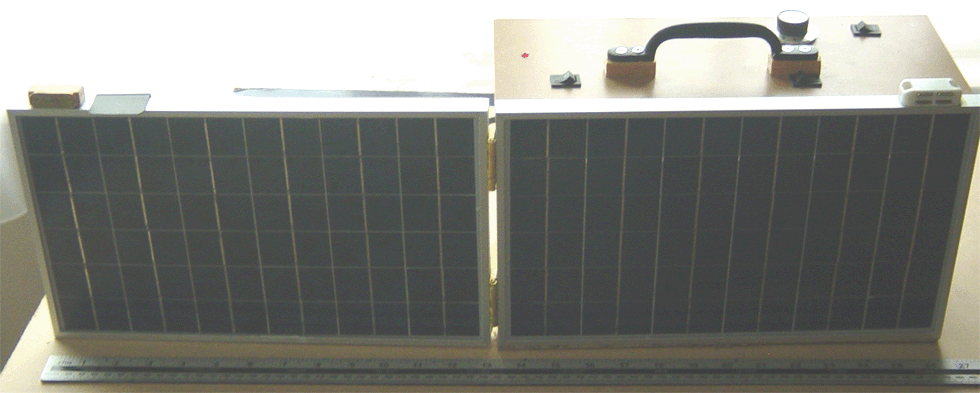 A magnetic catch is used to hold the hinged panel securely closed when the unit is being carried and a small flap is attached beside the magnetic catch to overcome the slightly excessive looseness of the hinges. The unit does not need to be as deep as this experimental model was made. The front view of the unit, ready to receive the frosted plastic cover for the LED arrays, looks like this: 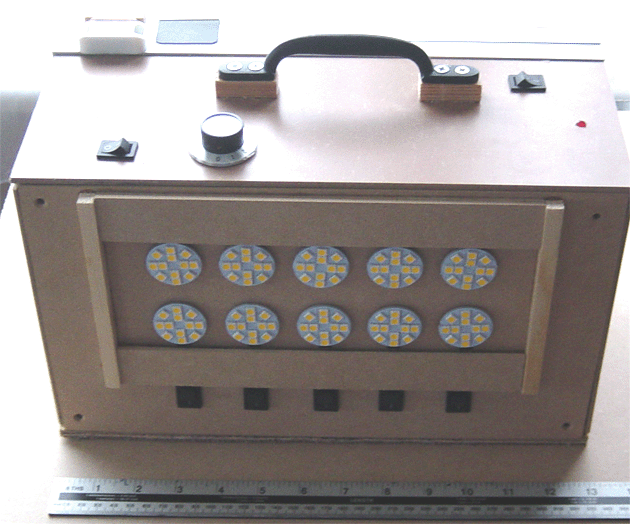 The underside of the unit is covered with a soft protective layer to ensure that it does not scratch any surface on which it is placed. In order to avoid the need for overcharging circuitry, this unit has six battery packs and so, having ten LED arrays, the duration of lighting is about the same as that of the desk lamp, although obviously, the light output can be much greater. With the greater lit area of ten LED arrays, a lower actual current can be used while still providing a good level of lighting. With fully charged batteries switched to the ‘boost’ setting, this unit puts out more light than a 100-watt incandescent bulb powered by the mains. Tested in daylight, that looks like this: 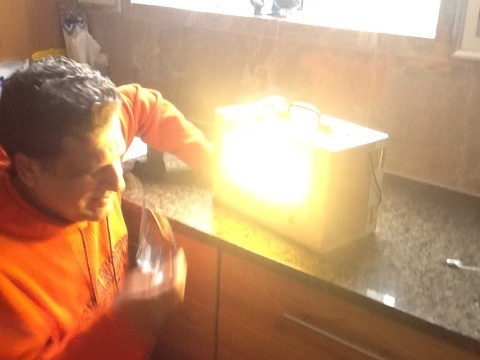 Let me stress again, that these units are not difficult to build. The battery boxes can be adapted quite easily by choosing where to connect to the battery pack: 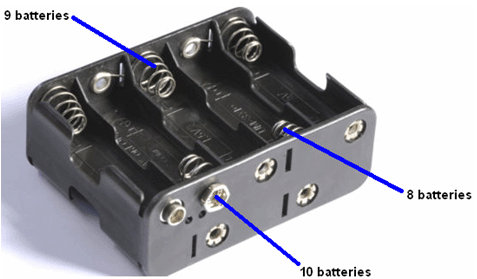 360 Degree Lighting for Africa The desktop lighting unit described above is very effective for lighting in cold areas where houses have windows with glass in them and where the roof does not project much beyond the house wall. However, housing style is very different in places like Africa where strong sunlight is experienced all year round and so a house roof is likely to project well beyond the wall in order to give improved shade for outside seating. Anna Brüderle’s “Solar Lamps – Africa” marketing research published by GIZ GmbH Uganda, has raised many previously unknown facts which should result in physical design changes. To date, I have produced three solar prototype lighting units, but these have been based on recharging using light coming through a glass window. That is not really possible in the African environment surveyed, as it shows: 1. Using a solar panel indoors is not possible due to lack of windows and major roof overhang. 2. Using a solar panel light being recharged outdoors is liable to have it stolen. 3. Using an outside solar panel connected by a wire is liable to damage and/or child injury when at play. The survey-area lifestyle has the following characteristics: 1. Seven people living in one building is not unusual and so 360-degree lighting is preferred. 2. The kitchen is normally separate and has no windows and yet needs meal-preparation lighting. 3. Burning a fuel for lighting is liable to cause poor health from the fumes produced. 4. Child education is hindered by lack of lighting. 5. Light usage is usually 3 or 4 hours at night plus 2 hours in the morning. 6. Tests with 100 lumen lighting level have been considered to be satisfactory. 7. Lamps are normally placed on the dining table during meals and hung from the ceiling at other times. 8. When carried outside, a narrow forward lighting arc of say, 90-degrees is preferred for safety. 9. Units with variable lighting levels are preferred but why is not specified – probably light duration. In these houses, there can be internal walls which do not reach the ceiling so that light in the central room spills over into the additional rooms. These features call for a lighting unit which is:
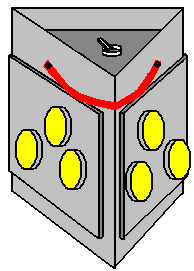 The triangular shape makes for easy construction and is very robust from an engineering point of view. It also cuts down the number of faces needed for 360-degree lighting to just three. The versatility is increased greatly if two faces are hinged: 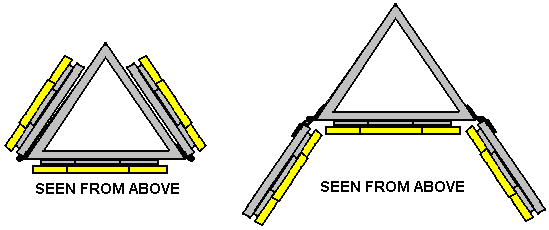 This arrangement allows two faces to be aligned with the fixed front face, giving all horizontal lighting in one direction which is a very, very bright arrangement. The two faces can be moved further around to give the wanted narrow forward beam for walking outdoors. If desired, the lighting level can be controlled by making the On/Off switch a three-pole four-way rotary switch: 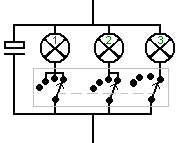 This arrangement gives Off, One panel, Two panels and Three panels of illumination, but it could also be that instead of switching off an entire panel that the switching illuminates one LED array per panel, two LED arrays per panel and three LED arrays per panel. If ordinary 10-battery holders are used, then the lamp housing can be made more compact as the corners of the triangle are not needed. The battery packs fit in like this: 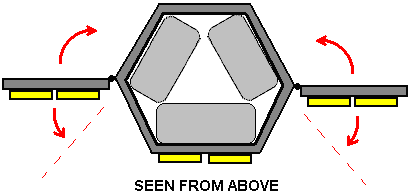 Giving a compact hexagonal shape which is strong and has the same lighting capability. The sides extend above the top and below the base so that the unit can stand on a flat surface either way up. The hinges need to be stiff so that they hold their position when set to the desired angle. 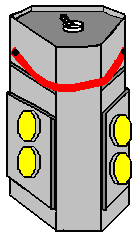 The addition of a simple hinged flap to the base allows a tilted option which imitates the downward lighting style of a desk lamp: 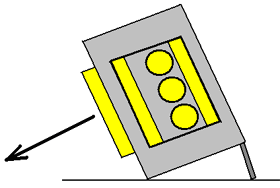 This unit is recharged by plugging it in to a small solar panel as before. This unit was never manufactured as the person who asked me to design it for him decided that it was too expensive as it would cost him £25 to make one. Patrick Kelly http://www.free-energy-info.tuks.nl http://www.free-energy-info.com http://www.free-energy-info.co.uk http://www.free-energy-devices.com |